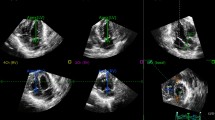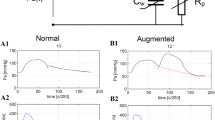Abstract
To compare stroke volumes (SV) in small hearts assessed by real-time three-dimensional echocardiography (3DE) with SV measured by transpulmonary thermodilution (TPTD) and continuous pulse contour analysis (PC) under various hemodynamic conditions. In thirteen anesthetized piglets (range 3.6–7.1 kg) SV were measured by 3DE, TPTD and PC at baseline and during phenylephrine and esmolol administration. 3DE and TPTD measurements were done successively while SV calculated by PC was documented at the time of 3DE. 3DE and TPTD showed a good correlation (r2 = 0.74) and a bias of −1.3 ml (limits of agreement −4.1 to 1.5 ml). While TPTD measured higher SV than 3DE, both methods tracked SV changes with a concordance rate of 91 %. PC and 3DE showed a lower correlation coefficient of r2 = 0.57 and a bias of −2.1 ml (limits of agreement −5.9 to 1.8 ml). Inter- and intra-observer variability of SV measured by 3DE was good with a mean bias <5 %. SV3DE showed a small variance and tracked acute small changes in SV in acceptable concordance with TPTD. PC measured SV with a higher variance and mean difference compared to 3DE. In an experimental setting 3DE has the possibility to offer non-invasive assessments of ventricular volumes volume changes. To determine whether 3DE could be used for SV assessment in a clinical routine our results need confirmation in a clinical setting.





Similar content being viewed by others
References
Tibby SM, Murdoch IA. Monitoring cardiac function in intensive care. Arch Dis Child. 2003;88:46–52.
Tibby SM, Hatherill M, Marsh MJ, Murdoch IA. Clinicians’ abilities to estimate cardiac index in ventilated children and infants. Arch Dis Child. 1997;77:516–8.
Proulx F, Lemson J, Choker G, Tibby SM. Hemodynamic monitoring by transpulmonary thermodilution and pulse contour analysis in critically ill children. Pediatr Crit Care Med. 2011;12:459–66.
Schiffmann H, Erdlenbruch B, Singer D, Singer S, Herting E, Hoeft A, Buhre W. Assessment of cardiac output, intravascular volume status, and extravascular lung water by transpulmonary indicator dilution in critically ill neonates and infants. J Cardiothorac Vasc Anesth. 2002;16:592–7.
Tibby SM, Hatherill M, Marsh MJ, Morrison G, Anderson D, Murdoch IA. Clinical validation of cardiac output measurements using femoral artery thermodilution with direct Fick in ventilated children and infants. Intensive Care Med. 1997;23:987–91.
Pauli C, Fakler U, Genz T, Hennig M, Lorenz HP, Hess J. Cardiac output determination in children: equivalence of the transpulmonary thermodilution method to the direct Fick principle. Intensive Care Med. 2002;28:947–52.
Tibby S. Transpulmonary thermodilution: finally, a gold standard for pediatric cardiac output measurement. Pediatr Crit Care Med. 2008;9:341–2.
Lemson J, de Boode WP, Hopman JCW, Singh SK, van der Hoeven JG. Validation of transpulmonary thermodilution cardiac output measurement in a pediatric animal model. Pediatr Crit Care Med. 2008;9:313–9.
Hanna BD. Where do we go from here? Cardiac output determination in pediatrics. Crit Care Med. 2008;36:1377–8.
Friedberg MK, Su X, Tworetzky W, Soriano BD, Powell AJ, Marx GR. Validation of 3D echocardiographic assessment of left ventricular volumes, mass, and ejection fraction in neonates and infants with congenital heart disease a comparison study with cardiac MRI. Circ Cardiovasc Imaging. 2010;3:735–42.
Riehle TJ, Mahle WT, Parks WJ, Sallee D, Fyfe DA. Real-time three-dimensional echocardiographic acquisition and quantification of left ventricular indices in children and young adults with congenital heart disease: comparison with magnetic resonance imaging. J Am Soc Echocardiogr. 2008;21:78–83.
Soriano BD, Hoch M, Ithuralde A, Geva T, Powell AJ, Kussman BD, Graham DA, Tworetzky W, Marx GR. Matrix-array 3-dimensional echocardiographic assessment of volumes, mass, and ejection fraction in young pediatric patients with a functional single ventricle: a comparison study with cardiac magnetic resonance. Circulation. 2008;117:1842–8.
Bu L, Munns S, Zhang H, Disterhoft M, Dixon M, Stolpen A, Sonka M, Scholz TD, Mahoney LT, Ge S. Rapid full volume data acquisition by real-time 3-dimensional echocardiography for assessment of left ventricular indexes in children: a validation study compared with magnetic resonance imaging. J Am Soc Echocardiogr. 2005;18:299–305.
Herberg U, Gatzweiler E, Breuer T, Breuer J. Ventricular pressure-volume loops obtained by 3D real-time echocardiography and mini pressure wire—a feasibility study. Clin Res Cardiol. 2013;102:427–38.
Herberg U, Brand M, Bernhardt C, Trier HG, Breuer J. Variables influencing the accuracy of 2-dimensional and real-time 3-dimensional echocardiography for assessment of small volumes, areas, and distances: an in vitro study using static tissue-mimicking phantoms. J Ultrasound Med. 2011;30:899–908.
Bland JM, Altman DG. Agreement between methods of measurement with multiple observations per individual. J Biopharm Stat. 2007;17:571–82.
Critchley LA, Critchley JA. A meta-analysis of studies using bias and precision statistics to compare cardiac output measurement techniques. J Clin Monit Comput. 1999;15:85–91.
Saugel B, Grothe O, Wagner JY. Tracking changes in cardiac output. Anesth Analg. 2015;121:514–24.
Hapfelmeier A, Cecconi M, Saugel B. Cardiac output method comparison studies: the relation of the precision of agreement and the precision of method. J Clin Monit Comput. 2015. doi:10.1007/s10877-015-9711-x.
Piehl MD, Manning JE, McCurdy SL, Rhue TS, Kocis KC, Cairns CB, Cairns BA. Pulse contour cardiac output analysis in a piglet model of severe hemorrhagic shock. Crit Care Med. 2008;36:1189–95.
Rupérez M, López-Herce J, García C, Sánchez C, García E, Vigil D. Comparison between cardiac output measured by the pulmonary arterial thermodilution technique and that measured by the femoral arterial thermodilution technique in a pediatric animal model. Pediatr Cardiol. 2004;25:119–23.
Boehne M, Schmidt F, Witt L, Köditz H, Sasse M, Sümpelmann R, Bertram H, Wessel A, Osthaus WA. Comparison of transpulmonary thermodilution and ultrasound dilution technique: novel insights into volumetric parameters from an animal model. Pediatr Cardiol. 2012;33:625–32.
Bajorat J, Hofmockel R, Vagts DA, Janda M, Pohl B, Beck C, Noeldge-Schomburg G. Comparison of invasive and less-invasive techniques of cardiac output measurement under different haemodynamic conditions in a pig model. Eur J Anaesthesiol. 2006;23:23–30.
Renner LE, Morton MJ, Sakuma GY. Indicator amount, temperature, and intrinsic cardiac output affect thermodilution cardiac output accuracy and reproducibility. Crit Care Med. 1993;21:586–97.
Yang B, Larson DF, Ranger-moore J. Biphasic change of tau(t) in mice as arterial load acutely increased with phenylephrine injection. PLoS One. 2013;8(4):e60580.
Lionetti V, Romano SL, Bianchi G, Bernini F, Dushpanova A, Mascia G, Nesti M, Di Gregorio F, Barbetta A, Padeletti L. Impact of acute changes of left ventricular contractility on the transvalvular impedance: validation study by pressure-volume loop analysis in healthy pigs. PLoS ONE. 2013;8:4–12.
Kutter APN, Bektas RN, Hofer CK, Larenza Menzies MP, Bettschart-Wolfensberger R. Trending ability and limitations of transpulmonary thermodilution and pulse contour cardiac output measurement in cats as a model for pediatric patients. J Clin Monit Comput. 2015;29:377–83.
Renella P, Marx GR, Zhou J, Gauvreau K, Geva T. Feasibility and reproducibility of three-dimensional echocardiographic assessment of right ventricular size and function in pediatric patients. J Am Soc Echocardiogr. 2014;27:903–10.
Acknowledgments
The authors thank Ute Lohmer, Dr. vet. Wolfgang Eichelkraut as well as Katharina Czeczor for their animal laboratory assistance, Nicola Rieder, Anna Hoppe and Ute Baur for their assistance in data analysis.
Funding
Deutsche Herzstiftung e.V., Frankfurt am Main, Germany (F/29/08 to U.H.), Else-Kröner-Fresenius-Stiftung, Bad Homburg, Germany (P15/06/A79/05 to U.H.), and Fördergemeinschaft Deutsche Kinderherzzentren e.V., Bonn, Germany (H-022.039 to U.H.)
Author information
Authors and Affiliations
Corresponding author
Ethics declarations
Conflict of interest
The authors declare that they have no conflict of interest.
Ethical approval
All applicable international, national and institutional guidelines for the care and use of animals were followed. All procedures performed in this study involving animals were in accordance with the ethical standards of the institution at which the studies were conducted.
Rights and permissions
About this article
Cite this article
Linden, K., Ladage, D., Dewald, O. et al. Comparison of stroke volumes assessed by three-dimensional echocardiography and transpulmonary thermodilution in a pediatric animal model. J Clin Monit Comput 31, 353–360 (2017). https://doi.org/10.1007/s10877-016-9843-7
Received:
Accepted:
Published:
Issue Date:
DOI: https://doi.org/10.1007/s10877-016-9843-7




